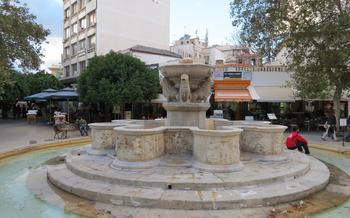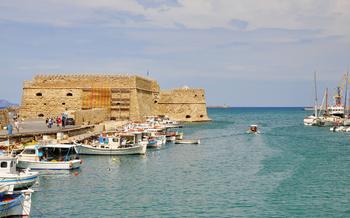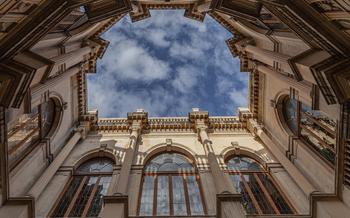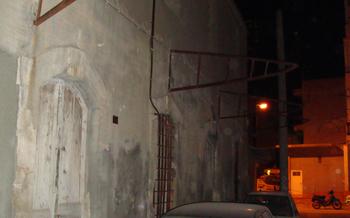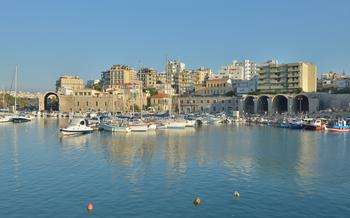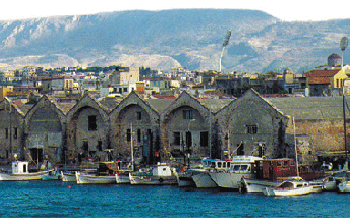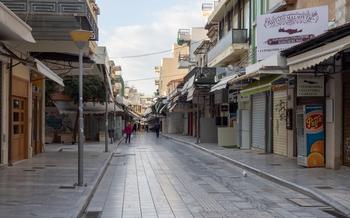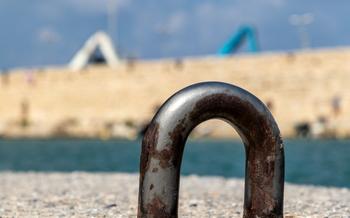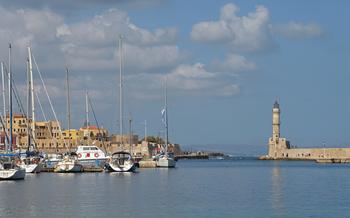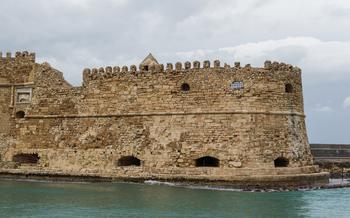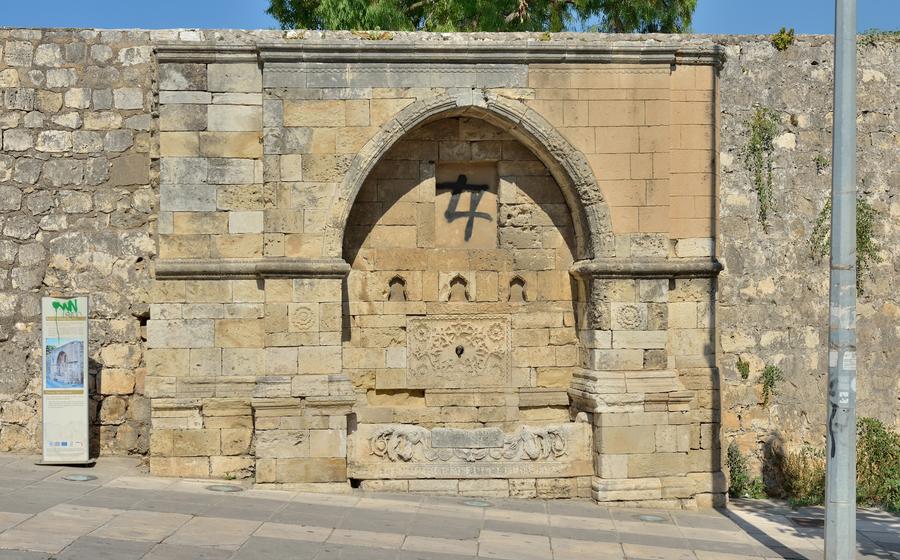
Venetian Walls of Heraklion
- Venetian Walls of Heraklion: A Symbol of Strength and Resilience
- Step Back in Time: Exploring the Fortifications
- The Lion of St. Mark: A Venetian Legacy
- A Walk Along the Ramparts: Unveiling Hidden Gems
- The Seaward Bastion: A Majestic Watchtower
- The Martinengo Bastion: A Bastion with a View
- The Arsenal: A Thriving Maritime Center
- The Venetian Gates: Gateways to the City
- The Venetian Fountains: Oases of Refreshment
- The Venetian Houses: A Glimpse into the Past
- The Venetian Palaces: Echoes of Aristocracy
- The Venetian Churches: Sacred Spaces of Worship
- The Venetian Festivals: Honoring the Past
- Insider Tip: Exploring the Walls at Sunset
Venetian Walls of Heraklion: A Symbol of Strength and Resilience
As you approach the city of Heraklion, the first thing that catches your eye is the imposing sight of the Venetian walls. These massive fortifications, built by the Republic of Venice between the 15th and 16th centuries, stand as a testament to the city's rich history and its strategic importance as a major port in the Mediterranean.
The walls, constructed from massive blocks of limestone and marble, were designed not only to protect the city from invaders but also to showcase the power and wealth of the Venetian Republic. Their impressive height and thickness, coupled with numerous towers, bastions, and gates, created a formidable barrier that few dared to challenge.
Today, the Venetian walls of Heraklion are one of the city's most iconic landmarks and a major tourist attraction. While some sections have been restored and incorporated into the modern city, others remain in their original state, offering a glimpse into the city's past.
Step Back in Time: Exploring the Fortifications
The Venetian Walls of Heraklion offer a journey through time, allowing visitors to step back into the era of Venetian rule. The fortifications consist of several sections, each with its own unique features. The Seaward Bastion stands out as a majestic watchtower, while the Martinengo Bastion boasts panoramic views and a rich history. Secret passages and hidden chambers add an air of mystery to the exploration, while the ramparts provide breathtaking views of the city and beyond.
Notable gates and bastions punctuate the walls, serving as gateways to different parts of the city. The Gate of the Arsenal leads to the Venetian harbor, while the Porta Ruota (Wheel Gate) offers access to the old town. Each gate and bastion has its own story to tell, reflecting the ingenuity and strategic prowess of the Venetian engineers.
Exploring the Venetian Walls is akin to embarking on a historical adventure. Visitors can imagine the medieval world coming alive as they stroll along the ramparts, surrounded by ancient stones that have witnessed centuries of history. The Venetian Walls stand as a testament to the enduring legacy of the Venetian Republic, inviting visitors to unravel the secrets and stories that lie within their imposing fortifications.
The Lion of St. Mark: A Venetian Legacy
The Venetian Walls of Heraklion are adorned with the iconic symbol of the Lion of St. Mark, a majestic creature that represents the strength and power of the Venetian Republic. These stone lions, with their stoic expressions and intricate details, are a testament to the enduring legacy of Venetian rule in Crete.
The lion statues were strategically placed at various points within the city, serving as a reminder of Venetian authority and dominance. One of the most prominent lions stands guard at the Seaward Bastion, overlooking the vast expanse of the Mediterranean Sea. Another can be found near the Arsenal, symbolizing the importance of maritime trade and shipbuilding during the Venetian era.
For the people of Heraklion, the Lion of St. Mark holds deep cultural significance. It represents their rich history and connection to the Venetian past. Stories and legends have been woven around these lions, adding to their mystique and allure. One popular tale tells of a lion that came to life and protected the city from an invading army.
Exploring the Venetian Walls of Heraklion offers a chance to discover these majestic lions, each with its unique story to tell. They stand as guardians of the city, embodying the strength, resilience, and pride of the Venetian era.
A Walk Along the Ramparts: Unveiling Hidden Gems
Begin your journey at the Martinengo Bastion, a massive fortification offering breathtaking views of the city and the sea. From here, follow the ramparts eastward, passing through the Jesus Gate and the Panigra Gate. Along the way, discover hidden chambers and secret passages that once served as defensive mechanisms.
Pause at the Arsenal Gate, a gateway to the city's former shipbuilding hub. Marvel at the intricate carvings and reliefs that adorn its arch, depicting scenes of naval battles and mythical creatures. Continue your walk, taking in the panoramic vistas from the ramparts. Capture stunning photographs of the Venetian harbor, the sprawling city, and the distant mountains.
As you approach the Seaward Bastion, admire the imposing structure that once guarded the city from seaborne attacks. Explore its chambers and corridors, now home to exhibitions and cultural events. Finally, end your walk at the Koules Fortress, a majestic sea fortress that stands as a testament to Heraklion's rich Venetian heritage.
The Seaward Bastion: A Majestic Watchtower
Overlooking the sparkling waters of the Mediterranean Sea, the Seaward Bastion stands as a testament to the strategic brilliance and engineering prowess of the Venetian era. This imposing fortification, also known as the Bastion of the Sea, played a crucial role in defending the city from maritime threats. Its commanding position allowed the Venetians to monitor and control access to the port of Heraklion, a vital gateway for trade and commerce.
The Seaward Bastion was meticulously crafted using sturdy stone and features a unique pentagonal shape, providing a wide field of vision and maximizing defensive capabilities. Its towering walls, adorned with intricate carvings and decorative elements, showcase the architectural mastery of the Venetian builders. The bastion's formidable structure has withstood the test of time, enduring centuries of storms, battles, and the relentless passage of time.
Today, the Seaward Bastion stands as a majestic symbol of Heraklion's rich maritime history. It has been carefully restored and repurposed into a vibrant cultural venue, hosting exhibitions, concerts, and other events that celebrate the city's Venetian heritage. Visitors can explore its atmospheric chambers, marvel at its architectural details, and soak in the breathtaking views of the sea and the surrounding cityscape.
Legends and myths abound about the Seaward Bastion, adding to its allure and mystique. One tale speaks of a secret tunnel that once connected the bastion to the Venetian fortress on the island of Spinalonga, allowing for swift and covert communication between the two strongholds. Another legend tells of a hidden treasure buried beneath the bastion, left behind by the Venetians as they abandoned the city. These stories, whether fact or fiction, contribute to the aura of mystery and intrigue that surrounds this iconic landmark.
The Martinengo Bastion: A Bastion with a View
The Martinengo Bastion, named after a Venetian governor of Crete, stands as a testament to the ingenuity and defensive prowess of the Venetian era. Constructed in the 16th century, this bastion played a crucial role in protecting the city from seaborne attacks. Its strategic location at the northwestern corner of the Venetian walls allowed for a clear view of the approaching enemy ships, providing ample time for the defenders to prepare.
The Martinengo Bastion boasts several unique features that set it apart from the other bastions. Its pentagonal shape, with five protruding angles, provided multiple firing positions for the cannons, maximizing the defensive capabilities of the bastion. The thick walls, reinforced with earthworks, could withstand even the most intense bombardments.
The bastion's design also incorporated several innovative elements. It featured a series of underground chambers and tunnels, allowing soldiers to move around unseen and protected from enemy fire. These secret passages also served as storage spaces for weapons, ammunition, and other supplies.
Today, the Martinengo Bastion stands as a well-preserved example of Venetian military architecture. It underwent extensive restoration efforts in recent years, which have helped to maintain its structural integrity and preserve its original features. Visitors can climb to the top of the bastion to enjoy panoramic views of the city, the harbor, and the surrounding countryside.
The Arsenal: A Thriving Maritime Center
In the heart of the Venetian harbor, a symbol of maritime prowess and economic might stands tall - the Venetian Arsenal. Established in the 13th century, this sprawling complex served as a bustling hub for shipbuilding and naval activities. Within its fortified walls, skilled craftsmen toiled tirelessly, constructing and repairing vessels that would sail the Mediterranean and beyond. The arsenal's strategic location, coupled with Venice's maritime expertise, transformed Heraklion into a thriving maritime center.
Today, the arsenal has undergone a remarkable transformation, evolving into a vibrant cultural venue that celebrates the city's rich maritime heritage. Its vast spaces now host a variety of exhibitions, art installations, and cultural events, showcasing the enduring legacy of the Venetian era. Visitors can immerse themselves in the history of shipbuilding, marvel at the intricate models of Venetian vessels, and discover the stories of the sailors who braved the open seas. The arsenal stands as a testament to Heraklion's maritime past, a reminder of the city's enduring connection to the sea and its Venetian roots.
The Venetian Gates: Gateways to the City
The fortified walls of Heraklion were pierced by several gates, each serving a specific purpose and contributing to the city's defense. The main gates included the Porta di San Giovanni, the Porta di Santa Caterina, and the Porta di San Rocco. These grand entrances, with their imposing arches and elaborate carvings, showcased the Venetian architectural style and reflected the city's status as a maritime power.
The Porta di San Giovanni, also known as the Pantocrator Gate, was the main entrance to the city from the east and led to the port area. The Porta di Santa Caterina, commonly called the Sea Gate, provided access from the north and was the gateway for travelers arriving by sea. The Porta di San Rocco, situated on the western side, served as the land gate and connected Heraklion to the mainland.
Today, these gates stand as remnants of Heraklion's Venetian past, offering a glimpse into the city's rich history. They remain significant landmarks, providing access to the old town and inviting visitors to explore the hidden treasures within the Venetian walls.
The Venetian Fountains: Oases of Refreshment
Amidst the labyrinthine streets of Heraklion, the Venetian fountains stand as testaments to the city's rich past and its enduring connection to water. These ornate structures were not merely functional, providing much-needed refreshment to weary travelers and residents alike, but also served as exquisite works of art, enhancing the city's visual appeal and contributing to its unique ambiance.
The most notable Venetian fountain in Heraklion is the Morosini Fountain, an elaborate creation featuring intricate carvings, spouting lions, and a majestic central figure representing the Venetian governor, Francesco Morosini. Located in the heart of the city, this fountain has become an iconic landmark and a popular meeting point for locals and tourists.
Other notable Venetian fountains in Heraklion include the Lion's Fountain, situated near the Venetian Walls, and the Bembo Fountain, located in the picturesque Koules Fortress. Each fountain possesses its own distinctive design and ornamentation, reflecting the artistic and cultural influences of the Venetian era.
Beyond their aesthetic value, the Venetian fountains hold cultural and historical significance. They served as gathering places for the community, where people could socialize, exchange news, and share stories. The fountains also provided a vital source of water for the city's inhabitants, especially during the hot summer months when water was scarce.
Today, the Venetian fountains continue to be cherished symbols of Heraklion's Venetian heritage. They stand as reminders of a time when the city was a thriving center of commerce and culture, and they contribute to the city's unique charm and allure. Strolling past these fountains, one can't help but be transported back in time, imagining the bustling streets and vibrant atmosphere of Venetian-era Heraklion.
The Venetian Houses: A Glimpse into the Past
Within the labyrinthine streets of Heraklion, the Venetian houses stand as silent witnesses to a bygone era. Built by the Venetian aristocracy and wealthy merchants, these architectural gems embody the grandeur and sophistication of the Venetian period. Their facades, adorned with intricate carvings, delicate balconies, and arched doorways, whisper tales of opulence and artistry.
Notable examples of Venetian houses include the Casa di Marco Sanudo, with its impressive Renaissance-style loggia, and the Casa di Bernardo, renowned for its stunning Gothic windows. These architectural masterpieces, scattered throughout the city, offer a glimpse into the lives of the Venetian elite.
Today, many Venetian houses have been meticulously restored and repurposed as charming boutique hotels, art galleries, and restaurants. Visitors can immerse themselves in the Venetian ambiance while enjoying modern comforts and amenities. Strolling past these architectural treasures, one can almost hear the echoes of laughter, music, and conversations that once filled their grand halls.
Preservation efforts are underway to ensure that these iconic structures continue to grace the cityscape of Heraklion. Local authorities and organizations work tirelessly to restore and maintain these architectural gems, recognizing their immense cultural and historical value.
Stories abound about the people who once inhabited these Venetian houses. From tales of love and intrigue to narratives of wealth and power, each house holds its own unique secrets. As visitors explore these architectural wonders, they can't help but feel a connection to the past, imagining the lives that unfolded within these walls centuries ago.
The Venetian Palaces: Echoes of Aristocracy
Heraklion boasts several magnificent Venetian palaces, testaments to the city's opulent past. These architectural jewels, once residences of wealthy Venetian families and government officials, exude an aura of grandeur and elegance. The Loggia, located in the heart of the city, stands as a prime example of Venetian Renaissance architecture. Its intricate carvings, graceful arches, and elegant loggia (open gallery) showcase the artistry and craftsmanship of the Venetian builders.
Another notable palace is the Palazzo Priuli, situated near the Venetian harbor. This imposing structure, with its rusticated facade and ornate balconies, once served as the residence of the Venetian governor. Its grand halls and lavish interiors reflect the opulence and power of the Venetian ruling class.
These Venetian palaces are not mere historical relics; many have been meticulously restored and repurposed to serve contemporary needs. The Palazzo Morosini, for instance, now houses the Historical Museum of Crete, showcasing a fascinating collection of artifacts and exhibits that narrate the island's rich history.
Exploring these Venetian palaces is like stepping back in time, immersing oneself in the grandeur and sophistication of a bygone era. They stand as living testaments to the enduring legacy of Venetian rule in Heraklion, inviting visitors to delve into the city's captivating past.
The Venetian Churches: Sacred Spaces of Worship
The Venetian rule in Heraklion left a significant imprint on the religious landscape of the city, with the construction of numerous churches that showcased the architectural prowess and devotion of the Venetian era. These sacred spaces stand as testaments to the deep faith and cultural exchange that took place during this period, blending Venetian influences with local traditions.
The Church of Agios Titos, built in the 16th century, is a prime example of Venetian ecclesiastical architecture, featuring a graceful bell tower and intricate carvings that adorn its façade. Inside, visitors are captivated by the serene atmosphere, beautiful frescoes, and the awe-inspiring iconostasis, which is considered a masterpiece of woodcarving.
Another notable church is the Church of San Marco, built in the 13th century and dedicated to the patron saint of Venice. Its austere exterior belies an opulent interior, adorned with stunning frescoes, marble sculptures, and a grand altar that exudes Venetian splendor.
These churches, and many others scattered throughout Heraklion, not only served as places of worship but also played a significant role in the social and cultural life of the city. They were venues for religious ceremonies, community gatherings, and artistic expression, fostering a sense of unity and belonging among the Venetian community.
Today, these Venetian churches continue to hold religious significance for the local population, while also attracting visitors who come to admire their architectural beauty and immerse themselves in the rich history of Heraklion. They serve as tangible reminders of the enduring legacy of Venetian rule, showcasing the deep connection between faith, art, and community.
The Venetian Festivals: Honoring the Past
Heraklion keeps the spirit of its Venetian past alive through a series of annual festivals that celebrate the city's rich heritage. These festivals immerse visitors in the vibrant culture and traditions of the Venetian era, offering a unique opportunity to witness the enduring legacy of the Republic of Venice.
The most notable of these celebrations is the Venetian Festival, held annually in late June or early July. During this festival, the city transforms into a living museum, with locals and visitors alike donning period costumes, engaging in historical reenactments, and participating in traditional Venetian dances and music performances. The streets are adorned with colorful decorations, and the air is filled with the sounds of merriment and revelry.
For history enthusiasts, the Venetian Heritage Days is a must-attend event. Held in September, this festival features lectures, exhibitions, and guided tours that delve into the fascinating history of Venetian Heraklion. Visitors can explore the city's Venetian landmarks, learn about the lives of its former inhabitants, and discover the stories behind the iconic Venetian symbols that adorn the city.
Throughout the year, various other festivals and events pay homage to the Venetian legacy of Heraklion. These include art exhibitions showcasing Venetian-inspired works, culinary events featuring traditional Venetian dishes, and theater performances that bring to life the tales of the Venetian era.
Participating in these festivals is a delightful way to immerse oneself in the unique blend of history, culture, and tradition that defines Heraklion. It is an opportunity to connect with the city's past, celebrate its Venetian heritage, and experience the enduring spirit of the Serenissima Republic.
Insider Tip: Exploring the Walls at Sunset
As the sun begins its descent, casting a warm golden glow over the Venetian Walls of Heraklion, a magical transformation takes place. The ancient stones seem to come alive, bathed in a soft, ethereal light that reveals intricate details often missed during the day.
For those seeking a truly unforgettable experience, a stroll along the ramparts at sunset is a must. The tranquil atmosphere, free from the daytime crowds, allows for a deeper connection with the history and beauty of these ancient fortifications.
Find a secluded spot to sit and savor the moment as the sky erupts in a symphony of colors. Capture breathtaking photographs of the walls and the surrounding cityscape bathed in the golden hues of twilight. Let the tranquility of the evening wash over you as you immerse yourself in the timeless charm of Venetian Heraklion.
This insider tip offers a unique perspective on the Venetian Walls, transforming a historical exploration into a truly magical and memorable experience.
